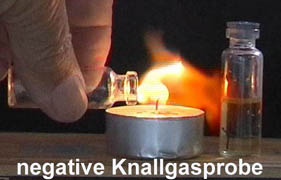 |
Subjects

|
|
| |
|
|
| |
|
|
|

   11- 11-

| E
111--------11111.
Set-up |
112.11
7 ml water + 7 mg Ca |
113.11
Volumetric gas generation |
11...............14.
bTest for
hydrogen1 |
  Preparing
a calcium sample, adding water, gas generation, combustion of the gas Preparing
a calcium sample, adding water, gas generation, combustion of the gas
Due to its shape and
the high surface tension of water the no-cost
ampoule can be totally filled with water, carefully turned upside
down (Photo 2) and brought into contact with a solid that reacts with
the water. If gases are produced they replace water inside the ampoule
(Photos 3). The volume of it is equivalent to the mass of the solid reactant.
The gas can be tested (Photo 4). By weighing the solid (Photo 1) and measuring
the gas volume a quantititative relation will be explored.
Material
Tray,
container for waste,
goggles, 2 hammers, digital pocket scale
(Diamond Series A04
or High-Precision Pocket Scale PS-20), gloves, ampoule 5 ml (high),
syringe (5ml), permanent marker, sticky tape,
aluminium beaker of a tea light, candle, scissors, grain of calcium, film
canister.
Procedure
1. Transform the ampoule
into a measuring container: Add water from a syringe in 1-ml-samples.
Mark each of the water surfaces. Protect the graduation
by sticky tape.
2. Photo 1:
After treating a grain of calcium by a hammer, cut the disk into quarters
and weigh them. (Attention: Wear gloves and keep the calcium dry!).
3. Photo 2:
Transfer one quarter of the calcium disk into a beaker. Totally fill the
ampoule with water. Carefully turn it upside down.
4. Photo 3:
Place the ampoule full of water with its mouth on
the calcium piece. Wait until the reaction is over. Measure the gas volume.
5.
Photo 4 :
Test
the gas for hydrogen.
Observations
a)
The
calcium piece reacts with water releasing gas bubbles that replace 4.6 ml of water
in the ampoule. A white precipitate is formed (Photo 3).
b) The gas has a smaller density than air. It burns without a bang ("negative
Knallgasprobe" = negative oxyhydrogen test)
(Photo 4).
Explanation
a)
During
the reaction Ca
+ 2 H2O
--> H2 + Ca(OH)2
1 mmol (40 mg) of Ca release 1 mmol (24 ml) H2
at room temperature. So the expected volume released by 7 mg of Calcium
is 4.2 ml.
b) The loudless combustion of the gas proves that it is hydrogen.
________________________________________________________________________________________________
first publication:
10.10.2008 l..l...last modification:
03.11.2008
l..l..l. back
pipette eudiometer to explode
oxyhydrogen gas. second period: pipette experiments with 20 mg samples
of calcium and calcium carbide. .....
|